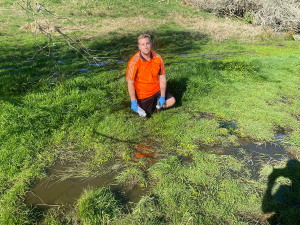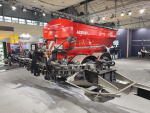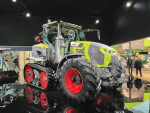“They work 365 days of the year, for nothing,” he told Rural News. “All I have to do is feed them.”
Fell and partners Michael Quintern and Tom McDowell own Ecocast, one of the biggest worm farms in New Zealand. Their “workforce” numbered about 400 million late last year and is increasing all the time. They’re employed across 6ha processing biosolids from the sewerage systems of Rotorua and Te Puke, mixed with pulp waste from the nearby Norske Skog paper mill.
The pulp is wood fibre that’s unsuitable for paper making. Historically it went to landfill but now Ecocast takes 7500t/year. The biosolids also formerly went to land fill but now Rotorua City Council delivers about 10,000t/year to Ecocast, and about 80t/month comes in from Te Puke’s treatment station.
“We are in negotiation with other councils as we could process a lot more,” comments Fell.
Incoming biosolids are dumped in a concrete pit then combined with wood fibre in a Keenan mixer wagon and laid in windrows 110m long, 10m wide and 500mm high.
Scoops of maturing material from earlier rows are added to new rows get the digestion process started, but as windrows mature and run out of nutrients – the biosolids are
high nitrogen, the wood waste is high carbon – worms naturally migrate to adjacent windrows to find new food.
“Most of the worms shift at the same time and can travel 100m overnight.”
Two types of worm are used: Tiger worms and Southern worms. Both are prolific breeders with a two year life span. They start breeding at four to six weeks depositing six capsules/week with 3-5 worms/capsule.
Six months after establishing a windrow any plant growth on top is sprayed and incorporated into the windrow where it’s processed by the worms.
New Zealand health and safety regulations dictate the residual vermicast from the windrows cannot be used for compost or on land used to grow crops for human consumption.
Fell says he accepts these rules but also that he believes it to be totally safe: it’s passed through worms at least five times in the windrow, he points out. The product has also passed as Aa grade as defined in the guidelines for the safe application of Biosolids to Land in New Zealand. (NZWWA 2003)
Only a quarter of the original volume of material is left, about 500t per row. PJ Brogden Contracting, Awakeri, remove and spread it, but cannot keep up with the demand.
“We spread most of it on ground being used to grow maize, mostly to repeat customers as well as new farmers who have seen the results.”
Brogden says maize growers report improved soil, more worms, and increased plant yields.
Fell’s partner in Ecocast, Michael Quintern, is also managing director of Noke Vermicomposting Solutions. Noke is the Maori word for worm and by the end of 2013 the various composting enterprises it’s involved with will have prevented 140,000t of waste from going to landfill.
“This is a significant saving in landfill area, and we can’t keep up with the demand [for vermicompost],” says Quintern.
“The potential to grow this industry to process formerly waste products has no limits.”
Quintern was raised on a farm in Germany and had a university career including a PhD on application of organic waste to farmland and 12 years’ lecturing before coming to New Zealand seven years ago.
His first role here was with the former Forest Research Institute in Rotorua, investigating land application of organic waste, which lead to research on worm farming and composting.
“I looked around and saw all this waste material on the one hand and demand for vermicast fertiliser and compost on the other. The surrounding pumice soils were crying out for organic material.”
After forming his company one of his first projects was with Tuaropaki Trust at Mokai south of Tokoroa. The Trust has 12ha of glasshouse tomatoes which create 2000t/year of reject fruit and vine waste. Combining this with fibre/wood waste from Kinleith mill means it’s all now turned into useful vermicast compost and fertiliser.
Quintern believes the dairy industry also has waste which could be converted into useful vermicomposting products.
“A large amount of waste is created just from the washings of plant and tankers. This is treated and when aerated forms a different DAF sludge that could be combined with timber waste and processed through a worm farm.”
Whatever product(s) are used, there are no smells created, he says.

















